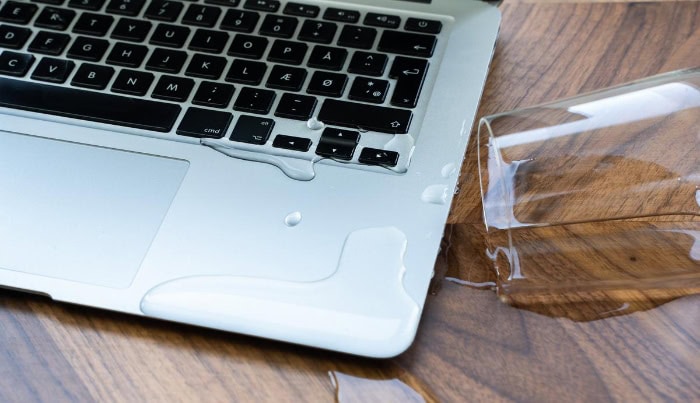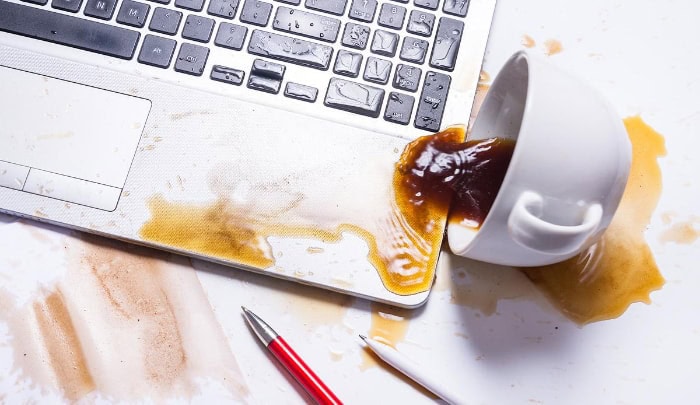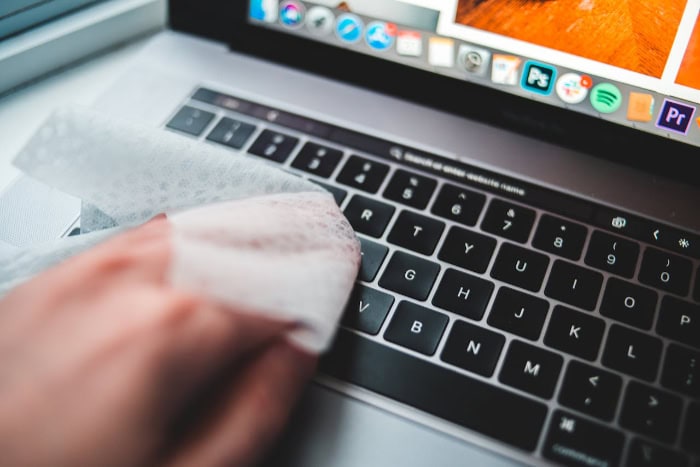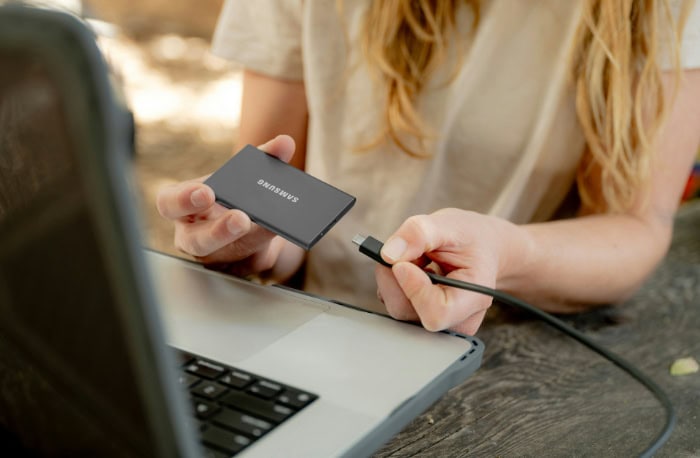What to Do When You Spill Liquid on Your Laptop

Few things are as panic-inducing as watching water or coffee spill onto your laptop, your mind racing with the potential damage it might have caused. Liquid and electronics don’t mix well, and even a small spill can result in short circuits, sticky keys, or irreversible hardware failure.
It’s a stressful situation, but staying calm and taking immediate action can make all the difference.
Immediate Steps to Take After a Spill
Accidentally spilling liquid on your laptop can be a heart-stopping moment, but what you do next is critical to minimizing damage. Reacting quickly and avoiding common mistakes can often save your device from permanent harm.
Here’s how to respond to the situation effectively.
Power Off and Disconnect
The first and most urgent step is to turn off your laptop immediately. Leaving it powered on while liquid is present increases the risk of short circuits that can damage internal components.
Press and hold the power button until the laptop shuts down completely. If it’s plugged into a charger, disconnect it right away to eliminate any electrical current flowing through the device.
Don't forget to unplug any accessories or peripherals, such as a mouse, external storage devices, or headphones, as moisture can spread to these through the ports.
Cutting off power as soon as possible helps protect your laptop’s internal circuits from further damage, so don’t hesitate during this step. Even if the spill seems minor, assume the worst and act promptly.
Drain the Liquid
Once your laptop is powered off, carefully flip it upside down to allow any trapped liquid to escape. Position it so the keyboard faces downward, which is typically where most spills occur.
Find a clean, absorbent surface, such as a towel, and place the laptop on it. This will help collect any liquid that drips out and prevent it from pooling in other areas of the device.
Gently shake the laptop if necessary to encourage excess liquid to drain, but avoid being too rough. If you can see large puddles of liquid on the surface, use a lint-free cloth to carefully dab it up without spreading it further.
Take your time with this process. While it won’t fix all the damage, removing as much liquid as possible early on improves the chances of your laptop recovering.
Avoid Common Mistakes
In the chaos of the moment, it’s easy to make missteps that can worsen the damage. One of the most important rules is to resist the urge to turn the laptop back on to check if it’s still working.
Powering it on too soon can cause permanent damage to internal components that are still wet.
Similarly, avoid using heat sources like hairdryers or space heaters to dry your device. Extreme heat can warp or damage delicate components, and blowing air into the laptop may push liquid further inside.
Allow the laptop to air dry naturally and follow safe techniques for cleaning and restoring it.
Assessing the Type and Extent of Damage

After dealing with the initial spill, the next important step is to evaluate the damage your laptop may have sustained. Not all spills affect laptops in the same way, as the type of liquid and the areas it reaches play a big role in determining the severity of the problem.
Type of Liquid
The nature of the liquid spilled can significantly impact the potential for harm. Plain water, while still dangerous, is less damaging than sugary or acidic liquids like coffee, soda, or alcohol.
Sugary drinks can leave behind a sticky residue that can interfere with the performance of your keyboard and other components. Over time, these residues can attract dust and trigger corrosion of the internal circuitry, leading to long-term issues.
Acidic liquids, such as some alcoholic beverages or citrus-infused drinks, can be even more harmful. The acids can accelerate corrosion inside the laptop, damaging essential parts like the motherboard and connectors.
If you spilled something other than water, cleaning the affected areas thoroughly becomes even more critical to prevent further degradation. Identifying the liquid type early on provides valuable insight into how much damage might have occurred and allows you to take targeted cleaning steps.
Affected Components
Liquid tends to seep into vulnerable areas of a laptop, causing different kinds of damage depending on where it travels. The keyboard is often the first component affected, as it sits directly beneath most spills.
You might notice sticky or unresponsive keys if liquid has pooled underneath. Keyboards with backlighting can also experience electrical faults due to moisture.
If the liquid reaches deeper into the device, more critical components like the motherboard, battery, or storage drive could be compromised. The motherboard, which acts as the central hub for communication between all hardware, is especially susceptible to liquid damage.
Short circuits in this area can cause the laptop to fail to boot, freeze, or shut down unexpectedly.
The battery is another sensitive component. Moisture can potentially lead to short circuits, reduced charging capacity, or in severe cases, overheating.
Additionally, liquid near the ports can prevent peripherals from working, as moisture may damage USB, HDMI, or charging ports and render them unfunctional.
Drying and Cleaning Your Laptop

Once you’ve powered off your laptop and removed as much surface liquid as possible, the critical process of drying and cleaning begins. Proper drying techniques and careful cleaning are essential to prevent long-term damage like corrosion or electrical faults.
Since liquids often reach internal components, taking the right approach can make a significant difference in your laptop’s chances of recovery.
Drying Techniques
Before attempting any repairs, the laptop needs to be thoroughly dried to eliminate remaining moisture. Start by using a lint-free cloth to dab any visible liquid on the surface of the device.
Avoid rubbing, as this can push liquid deeper into the internal components or spread it to unaffected areas. Pay close attention to the keyboard, trackpad, vents, and any ports, as these are common entry points for liquid.
Once visible moisture has been removed, place the laptop in an inverted position, ensuring the keyboard is facing downward. This allows any trapped liquid to drain naturally while preventing it from flowing further inside.
Leave the laptop in this position for at least 24 hours, but ideally 48 to 72 hours to allow it to air dry completely. Resist the urge to use hairdryers or similar heat sources, as these can damage delicate hardware and cause warping.
Instead, a gentle flow of air from a fan can help speed up the drying process without creating additional risks.
During this time, patience is key. Attempting to power on the laptop before it’s fully dry could lead to short circuits or greater internal damage, which are far more difficult and expensive to repair.
Cleaning Internal Components
If you’re comfortable working with electronics, cleaning the internal components of your laptop can be an effective way to address any sticky or corrosive residue left behind by sugary or acidic liquids. Begin by carefully disassembling the laptop.
This may involve removing the back panel, the battery, or other parts, depending on the model. Always refer to the manufacturer’s guidelines for proper disassembly to avoid causing further damage.
Once the necessary parts are exposed, use isopropyl alcohol with a concentration of 90% or higher to clean affected areas. Isopropyl alcohol is effective at removing residue and dries quickly without leaving moisture behind.
Apply the alcohol to a cotton swab or a lint-free cloth and gently clean any sticky or discolored areas, particularly around the motherboard, ports, or connectors. Avoid pouring the alcohol directly onto components to prevent pooling, which could create new problems.
Take your time with this process, ensuring that all sticky or sugary substances are removed. Even small amounts of residue can lead to corrosion over time, causing critical components to fail weeks or months down the line.
Reassemble the laptop only when you’re confident that all parts are dry and clean.
When to Seek Professional Help
Not all spills can be resolved with basic drying and cleaning techniques, and it’s sometimes necessary to involve a professional. If the liquid has extensively reached the internal circuitry, or if the laptop shows no signs of life even after drying, professional repair is strongly recommended.
Similarly, if you lack experience with disassembling electronics, attempting to clean the internal components yourself could inadvertently cause further damage.
Certain symptoms, such as the laptop failing to boot, a flickering screen, unusual noise, or visible corrosion on internal parts, are indications that professional inspection is warranted. Trained technicians have the tools and expertise to assess the extent of the damage, repair or replace affected parts, and optimize your laptop’s performance.
If your device holds critical data or is particularly valuable, this can be a worthwhile investment to recover both your hardware and your files.
Recovering Data from a Damaged Laptop

For many people, the prospect of losing important files can be even more stressful than the hardware damage caused by a liquid spill. Documents, photos, and other valuable data stored on your laptop could still be recoverable, even if the laptop itself isn’t functioning properly.
Assessing Data Accessibility
Once your laptop has dried completely and you are ready to test it, the first step is to check whether it powers on without any unusual behavior. If it turns on and functions as expected, you’re in luck.
Take this opportunity to back up all critical files immediately, as lingering residue or corrosion from the spill could still cause later issues. It’s best to move your important data to an external hard drive or cloud storage as a precaution.
If the laptop exhibits signs of hardware trouble, such as refusing to boot, showing error messages, or making strange noises, the storage drive (such as the hard drive or SSD) may still be intact even if other components are not. Similarly, if the laptop powers on but files are missing or corrupted, these could be signs that data recovery measures are needed.
Addressing these signs promptly can help reduce the risk of permanent file loss.
Data Recovery Options
If your laptop cannot be powered on safely or hardware malfunctions prevent access to your files, removing the storage drive is often the best next step. Most modern laptops use either a solid-state drive (SSD) or a traditional hard disk drive (HDD) to store data.
These drives are typically housed internally and can be carefully removed with the right tools and knowledge.
Once removed, the drive can be connected to another working computer using an external drive enclosure or adapter. This bypasses the damaged laptop entirely and allows you to retrieve and back up your files directly.
For users who are comfortable with basic technical tasks, this is often a quick and effective solution for accessing files that are still intact.
If the drive is damaged or appears inaccessible even when connected to another device, professional data recovery services may be your best option. These services specialize in retrieving files from faulty or damaged drives, even in cases of physical harm or severe corruption.
While this can be a more expensive route, it can provide peace of mind when dealing with irreplaceable files. If you’re unable to resolve the issue on your own, consulting a professional ensures you don’t risk losing important data through improper handling.
Preventing Future Spills

While accidents can happen to anyone, taking proactive steps to prevent spills around your laptop can save you from the stress and expense of dealing with liquid damage. Incorporating both protective tools and safe habits into your routine can significantly reduce the chances of another mishap.
With just a few small adjustments, you can create a workspace that is safer for your electronics and more efficient for you.
Protective Measures
One of the simplest ways to shield your laptop from potential spills is by investing in protective accessories. Waterproof keyboard covers or silicone skins are inexpensive and effective at keeping liquids from seeping under the keys.
These covers fit snugly over the keyboard and act as a barrier, preventing spills from reaching internal components if an accident occurs. They are also easy to clean, making them a practical addition for anyone who frequently works around drinks.
For those who experience spills more regularly, a spill-resistant laptop may be worth considering. These models are designed with extra sealing around sensitive parts and drainage systems to reduce the damage caused by liquids.
While they may cost a bit more upfront, they offer extra peace of mind for users who routinely work in environments where spills are likely.
Safe Habits
Changing your habits can also make a big difference in protecting your laptop. Keeping beverages away from your work area is one of the simplest yet most effective precautions.
Instead of placing drinks near your laptop, consider setting up a designated space for beverages that is at a safe distance from your electronic devices. Even placing a drink just a few feet away can prevent a small bump from spilling liquid directly onto your machine.
Avoid placing open containers on desks where your laptop and other electronics are located. Opt for sealed or spill-proof travel mugs instead, as these are less likely to tip over.
If space is limited, position your laptop on a raised stand or use a dedicated desk organizer to create a safer layout. Making these small adjustments not only protects your device but also creates a more organized and efficient workspace.
Preventing future spills may require a mix of preparation and mindfulness, but the benefits are well worth the effort. Protective measures and safe habits work hand in hand to keep your laptop safe, allowing you to work or study without the constant worry of accidental damage.
Conclusion
Accidentally spilling liquid on your laptop can be a stressful experience, but acting quickly and following the right steps can often make all the difference. Powering off the device, drying it thoroughly, and cleaning sticky or corrosive residues are crucial to minimizing damage.
Assessing the type of liquid and the areas affected helps you understand the severity of the impact, while professional help may be necessary for more extensive damage.
Recovering valuable data from a damaged laptop is still possible in many cases, whether by carefully accessing the storage drive yourself or relying on professionals for assistance. Beyond repairs, adopting preventive measures such as using protective covers and practicing safe habits can significantly reduce the risk of future spills.
While accidents might not always be avoidable, being prepared and acting promptly gives you the best chance to protect both your laptop and the data stored on it. Simple steps and mindful habits can go a long way in keeping your device safe and functional for years to come.


